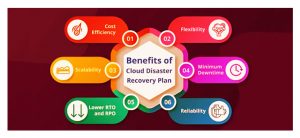A disaster can strike at any time, affecting the distribution of your software products to clients as well as the operation of your organization. Downtime may put your business to a standstill, whether it’s due to a network outage, a natural disaster, or a fault in your code, resulting in wasted time, customers, and income.
That is why it is critical to have a disaster recovery (DR) plan. Traditional DR techniques are both costly and time-consuming. Creating the necessary backup architecture to enable a speedy and efficient recovery is easier and more cost-effective than ever before thanks to cloud computing.

What is Disaster Recovery in the Cloud?
Cloud disaster recovery (CDR) is a managed cloud solution that enables you to quickly recover your organization’s essential systems following a disaster and gives you remote access to your systems in a secure virtual environment.
How Does Cloud Changes Disaster Recovery?
When it comes to disaster recovery, the cloud, notably virtualization, takes a totally different approach. The complete server, including the operating system, programs, patches, and data, is contained in a single software bundle or virtual server when virtualization is used. In a matter of minutes, this entire virtual server may be replicated or backed up to an off-site data center and started up on a virtual host.
Because the virtual server is hardware agnostic, the operating system, applications, fixes, and data may be transported safely and precisely from one data center to another without the need to reload each component of the server.With cloud computing, backups of your important servers can be spun up in minutes on a shared or dedicated host platform, making warm site disaster recovery a very cost-effective solution.
With SAN-to-SAN replication between sites, hot site DR with very short recovery times becomes a significantly more tempting and cost-effective solution. One of the most intriguing aspects of cloud disaster recovery is the possibility to provide multi-site availability.
The advantage of the disaster recovery in the cloud is the opportunity to fine-tune the DR platform’s pricing and performance. In the event of a disaster, apps and servers that are deemed less vital can be tuned down with fewer resources, while ensuring that the most critical applications have all of the resources they require to keep the business going.
Networking is the New Critical Path in Disaster Recovery
The long straw has become network replication, thanks to the sea change in disaster recovery brought forth by cloud computing. The important step for a disaster recovery operation is replicating the production network at the DR site, including IP address mapping, firewall rules, and VLAN configuration, with fast server recovery at an offsite data center.
Wrapping Up
Cloud computing has numerous advantages, including cost-effective resource utilization, quick provisioning, scalability, and elasticity. One of the most significant advantages of cloud computing is the paradigm shifting that brings to disaster recovery. The cost of disaster recovery on the cloud drops dramatically, allowing many more businesses to deploy comprehensive DR plans for their whole IT infrastructure. At a fraction of the expense of traditional disaster recovery, cloud disaster recovery offers speedier recovery times and multi-site availability.
